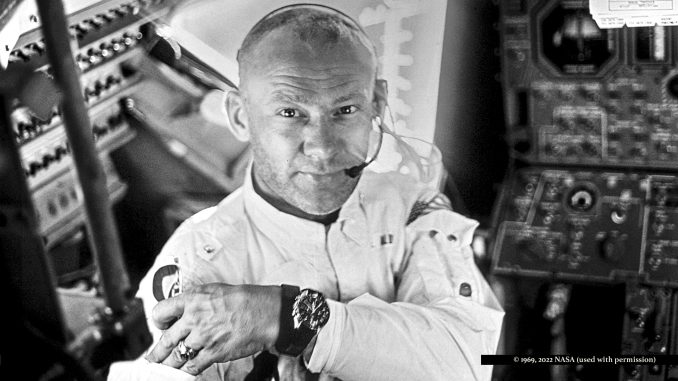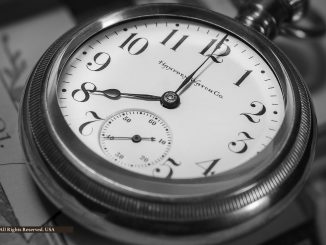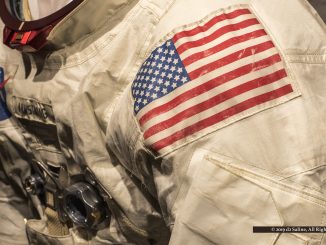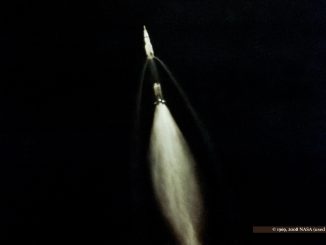
This coming July 20 will mark the fifty-third-year anniversary of the date on which man first set foot on the surface of the moon. When Saline Journal was on-site to cover 2019 commemorations at the Armstrong Air & Space Museum, visitor numbers were at an all-time high. [1-3]
In one retrospective, The Guardian described technology behind this achievement as having been backed by “less computing power than a washing machine.” The 30 kilogram Apollo Guidance Computer ran with a processor frequency of 2.048 megahertz, operated on the same power consumption as a household lightbulb, and was “equivalent to the computing power of a contemporary pocket calculator.” [4-7]
And yet it never failed at any point during the entirety of the Apollo program.
At once both breathtaking and humble as STEM circa 1969 was in terms of what was achieved, it does not appear to be what is most compelling in exhibitions of artifacts such as those on display in “Apollo: When We Went to the Moon” at The Henry Ford — running through the end of this weekend. Rather, visitors are seen stopped by actual castings of astronaut hands, used to produce custom-fitted space suit gloves; or the opportunity to actually sit in a scale-replica lunar rover. [8]
Outside of any display case, an intimate, persisting manifestation of connection to those six Apollo landings is through the Omega Speedmaster as first (if not only) wristwatch model worn on the moon. Resurgences of interest in the Apollo 13 mission evidenced the lifesaving value of its chronograph functioning. [9-20]
Those inclined to more granular research on this subject made it a point to emphasize that the first watch worn on the moon was not on the wrist of Astronaut Neil Armstrong. [21]
“It’s aways been the number one selling Omega,” Saline Journal was told earlier this week by David Kingston (DK), Watch Manager for Lewis Jewelers in Ann Arbor Michigan, based on his thirty-four year tenure. Over the years, he and Lewis Jewelers have served as important resources in providing timepieces for four James Bond themed exhibitions at the National Watch & Clock Museum in Pennsylvania. [22-25]
Additionally, DK is “Grand Ambassador” Omega Watches.
Here, he spoke about this in terms of dedication that Omega had shown through housing its own museum in Biel, which includes artifacts that have gone into space, then returned. He talked about having had the opportunity to meet with astronauts — and talk with them about their Apollo watches.
“One of them said to me, ‘I honestly didn’t think I was coming back,'” DK recalled. “Then he did come back — and his watch was a part of that, a part of what worked, tried-and-true, time after time.
This is old school; they’re from a different time. What they did, and what the space program does, is as real as it gets. And, honestly: When you have something that works, with everything on the line, they don’t want to change it.
And Omega gets that when they release new variations on those moon watches. People want to wear the watches they buy, and there are different things that interest them; so Omega makes different versions. They put their latest technology into them, like making them impervious to magnetic fields, because of where people wear their watches when they work today. They offer models with exhibition casebacks so that people can see the mechanisms — which is particularly nice on these watches, without the rotar obstructing the view.
“But you want to know what’s wild?” he asked rhetorically, with an added spark of excitement in his eye.
People still want Hesalite crystals: A lot of people still want watches with Hesalite crystals. [27]
That was the technology of the day, and its hard to think of modern luxury watches without sapphire crystals.
But for the space program, in zero gravity, breaking the crystal on your wristwatch inside a space capsule would be a catastrophe.
Sometimes customers ask me, ‘What if I scratch it?’ These crystals do scratch. But they’ve always scratched, as long as they’ve been around. So I tell them to bring it back into the store and I’ll polish it back to ‘new,’ for as long as they own it. Just like Omega dealers did for their customers in the 1960s; it only takes a few seconds.
And we still use our original polishing wheel from the time to do that here.
Visitors to Apollo: When We Went to the Moon enter the special exhibits gallery by passing sizable displays of satellites and exactingly proportioned models of rockets that compared differing approaches to “The Space Race.” They then enter a more expansive area, notably anchored by a sort of “news stand” setup, appointed with various sort of media coverage from July, 1969. Invariably, they stop — and hang around in that area for more than bit. [28,29]
A dozen years ago, David Adam quoted Tim Stevenson, Chief Engineer, Leicester University Space Research, for a forty-year retrospective on Apollo.
The real achievement of Apollo, “was less tangible than the programme’s whizz-bang technology …. ‘Apollo was the combination of technologies, none of which was particularly dramatic. Combining it was the achievement. This was a bunch of people who didn’t know how to fail ….’
That, it seems, is what keeps bringing people back to touchstones of what was Apollo — whether commemorated in Wapakoneta Ohio, in some imagined step back in time to an newspaper stand, or checking the time on their wrist as viewed through legacy plexiglass. [30]
References
- “The First Person on the Moon” National Aeronautics and Space Administration (NASA).
- Armstrong Air & Space Museum (home page).
- “On July 20, 1969 The United States of America safely put men on the moon – and hoped to return them safely home after” Dell Deaton (July 20, 2019) Saline Journal.
- “With less computing power than a washing machine” David Adam (July 1, 2009) The Guardian.
- “Computing Power of Apollo 11 & The Tech Behind It” Phil Goldstein (July 18, 2019) FedTech.
- “The computer which landed Apollo 11 on the Moon was about as powerful as a contemporary pocket calculator” Domagoj Valjak (March 27, 2017) The Vintage News.
- “Don’t forget the computer that landed Apollo 11 astronauts on the moon” Keith Wagstaff (July 20, 2019) Mashable.
- “Apollo: When We Went to the Moon” (February 19, 2022 – May 8, 2022) The Henry Ford.
- “Apollo 11 Mission Overview” NASA.
- “Apollo 12” NASA.
- “Apollo 14” NASA.
- “Apollo 15” NASA.
- “Apollo 16” NASA.
- “Apollo 17” NASA.
- “Why we’re still obsessed with the watches astronauts wore to the moon” Rob Verger (October 11, 2019) Popular Science.
- “The Moonwatch — The Speedmasters That Went To The Moon” Robert-Jan Broer (July 21, 2020) Fratello.
- “Not quite such a blue moon. Why Omega is not the only moon watch” (July 24, 2019) Martin Skeet.
- “Apollo 13 – Trailer” Universal Pictures All-Access (April 12, 2011) YouTube (1:37 minutes).
- “Apollo 13” NASA.
- “Apollo 13 and Omega: 50 Years Later” Omega (April 11, 2020) YouTube (2:10 minutes).
- “What watches were worn on/near the moon …” (February 27, 2007) Chuck Maddox.
- “Speedmaster: Moonwatch Professional” Omega Watches.
- Lewis Jewelers (home page).
- “National Watch & Clock Museum” National Association of Watch & Clock Collectors.
- “James Bond Wore the Quartz Revolution” Dell Deaton (June 1, 2015) Vimeo (3:05 minutes).
- “Museum” Omega Watches.
- “Why Every Speedmaster Fan Needs A Model With Hesalite Crystal” Gerard Nijenbrinks (December 1, 2020) Fratello.
- “What Was the Space Race?” Adam Mann (August 7, 2019) Space.
- “The Space Race” The Miller Center.
- Wapakoneta Area Chamber of Commerce (home page).



